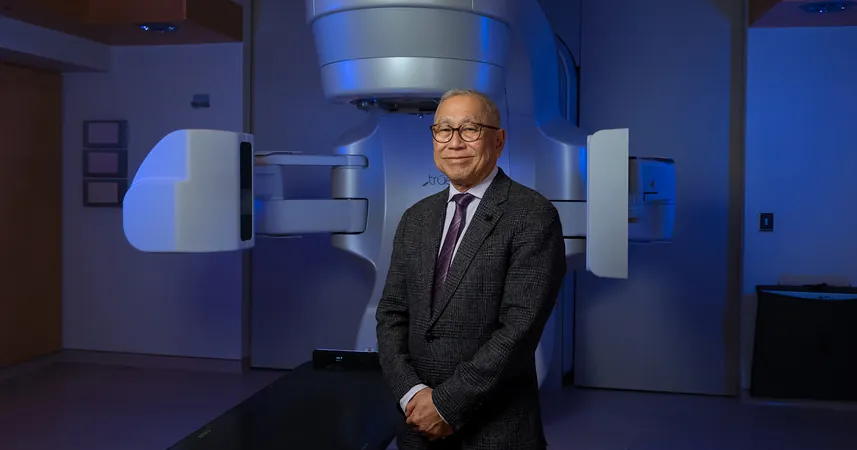
Life-Saving $1.35 Million Donation Launches Groundbreaking Ventricular Tachycardia Program!
2025-04-01
Author: William
In a remarkable turn of events, Steve Strba's life was saved on a Toronto golf course, thanks to the swift actions of a golf club professional. Strba, who collapsed and experienced cardiac arrest—his heart stopping for a harrowing seven minutes—was revived by the quick-thinking pro who administered CPR even after paramedics arrived on the scene.
Just a year before this near-tragic incident, Strba was diagnosed with ventricular tachycardia (VT), a potentially deadly arrhythmia that can cause heart palpitations and dizziness. If not treated, VT can lead to sudden cardiac arrest, making awareness and intervention critical.
Leading the charge in addressing this condition is Dr. Anthony Tang, a renowned professor at the Schulich School of Medicine & Dentistry's Cardiology Division and researcher at the London Health Sciences Centre Research Institute (LHSCRI). Dr. Tang is internationally acclaimed for his pioneering studies in device therapy for arrhythmias and heart failure.
He explains that VT often arises from underlying heart disease, manifesting as scars or damage within the heart. Current treatments—such as medications and invasive catheter ablation—aim to reset the heart's rhythm. However, not all patients respond to these therapies, and some may be too fragile for invasive procedures.
To tackle this challenge, Dr. Tang has spearheaded the innovative stereotactic arrhythmia radioablation (STAR) program at the London Health Sciences Centre. This non-invasive treatment uses advanced mapping and photon therapy to target and treat the source of VT, similar to how radiation is deployed in cancer therapy. By directing radiation at the affected area without invasive surgery, the STAR program offers a promising alternative for patients who are not viable candidates for traditional methods.
Studies so far indicate that STAR shows effectiveness in treating VT, but further research is essential to assess long-term outcomes and optimize the method for managing heart movement during the procedure.
Thanks to a generous $1.35 million donation from the H²HCo (Here to Help, Co.) Foundation—an organization that Strba and his wife Cathy Yantsis are closely affiliated with—Dr. Tang has assembled a team of top-tier experts in various fields, including cardiac electrophysiology, cardiac imaging, medical biophysics, and radiation oncology, to advance this vital research.
"This collaboration harnesses the incredible expertise within our university, hospitals, and research facilities, essential for the success of the STAR program. The donation ignited our potential to progress," stated Dr. Tang.
He envisions a future where patients like Strba can receive treatment for VT in a safer, more efficient manner—potentially within a single outpatient visit. This revolutionary approach could allow patients to return to their everyday lives quickly, transforming the landscape of care for those plagued by heart issues.
Dr. John Yoo, dean of Schulich Medicine & Dentistry, emphasized the urgency of such innovations, citing heart disease as the second leading cause of death in Canada. He expressed immense gratitude for H²HCo's investment in Dr. Tang’s research, highlighting the continuous advancements in cardiovascular medicine taking place at their institution.
Despite his past health scare, Strba has returned to an active lifestyle, integrating a holistic health regimen that combines medication, yoga, meditation, and rowing—a passion he developed while studying chemistry at Western University.
Strba's commitment to enhancing treatment options for others with VT is driven by a heartfelt motivation. "It’s not just about my story," he said. "Cathy and I aim to support others facing similar challenges, believing in the importance of community care."
"What Dr. Tang is doing is not only visionary but also incredibly thrilling, and it's astonishing that such pioneering work is happening right here in our community," he added.
As the STAR program kicks off, the hope is to pave the way for revolutionary treatments that could change countless lives impacted by ventricular tachycardia, a promising step forward in the journey toward heart health innovation.









 Brasil (PT)
Brasil (PT)
 Canada (EN)
Canada (EN)
 Chile (ES)
Chile (ES)
 Česko (CS)
Česko (CS)
 대한민국 (KO)
대한민국 (KO)
 España (ES)
España (ES)
 France (FR)
France (FR)
 Hong Kong (EN)
Hong Kong (EN)
 Italia (IT)
Italia (IT)
 日本 (JA)
日本 (JA)
 Magyarország (HU)
Magyarország (HU)
 Norge (NO)
Norge (NO)
 Polska (PL)
Polska (PL)
 Schweiz (DE)
Schweiz (DE)
 Singapore (EN)
Singapore (EN)
 Sverige (SV)
Sverige (SV)
 Suomi (FI)
Suomi (FI)
 Türkiye (TR)
Türkiye (TR)
 الإمارات العربية المتحدة (AR)
الإمارات العربية المتحدة (AR)